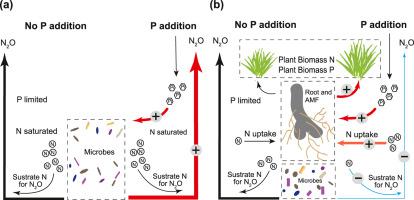Rhizosphere ( IF 3.4 ) Pub Date : 2021-07-17 , DOI: 10.1016/j.rhisph.2021.100414 Yawen Shen 1 , Tianle Xu 1, 2 , Baodong Chen 3 , Biao Zhu 1

|
Although phosphorus (P) addition and arbuscular mycorrhizal fungal (AMF) colonization have potential for mitigating soil N2O emission, the effects and mechanisms remain unresolved. We conducted a pot experiment with ryegrass (Lolium perenne) growing in a growth chamber for 80 days with three factors: Plant and AMF presence (unplanted, with plants, with plants colonized by AMF), two nitrogen (N) addition levels (0 and 50 mg N kg−1 soil) and two P addition levels (0 and 20 mg P kg−1 soil). Our results showed that N addition and AMF colonization had insignificant effects on soil N2O emission. However, the presence of plants decreased soil N2O emission by 90%–99% (planted vs. unplanted) under P addition. Moreover, P addition increased (+134%) N2O emission from unplanted soil, but decreased (74%–98%) it from planted soil. Further analysis showed that soil N2O emission was controlled by soil available P, soil NO3−-N, plant biomass P and N across all treatments. The lower N2O emissions from planted soils were mainly due to the lower soil NO3−-N content which might be immobilized by plant biomass, while the higher N2O emissions from unplanted soils under P addition were attributed to the increased soil available P content. Furthermore, we found an antagonistic effect between AMF inoculation and P addition on soil N2O emission because sufficient soil P may inhibit AMF colonization and activity. Taken together, we conclude that plant presence combined with P addition can effectively reduce N2O emission from P-limited soils.
中文翻译:

土壤 N 2 O 排放对磷添加和植物存在比对氮添加和丛枝菌根真菌接种更敏感
尽管磷 (P) 添加和丛枝菌根真菌 (AMF) 定植具有减少土壤 N 2 O 排放的潜力,但其影响和机制仍未得到解决。我们对在生长室中生长 80 天的黑麦草 ( Lolium perenne )进行了盆栽试验,其中包含三个因素:植物和 AMF 的存在(未种植的、有植物的、植物被 AMF 定殖)、两种氮 (N) 添加水平(0 和50 mg N kg -1土壤)和两个 P 添加水平(0 和 20 mg P kg -1土壤)。我们的结果表明,N添加和AMF定植对土壤N 2 O排放的影响不显着。然而,植物的存在降低了土壤 N 2在 P 添加下,O 排放量增加 90%–99%(种植与未种植)。此外,P添加增加了(+134%)未种植土壤的N 2 O排放,但减少了(74%–98%)种植土壤的N 2 O排放。进一步的分析表明,在所有处理中,土壤 N 2 O 排放受土壤有效磷、土壤 NO 3 - -N、植物生物量 P 和 N 的控制。种植土壤中较低的 N 2 O 排放主要是由于较低的土壤 NO 3 - -N 含量可能被植物生物量固定,而较高的 N 2添加磷后未种植土壤的 O 排放归因于土壤有效磷含量的增加。此外,我们发现 AMF 接种和 P 添加之间对土壤 N 2 O 排放的拮抗作用,因为充足的土壤 P 可能会抑制 AMF 的定植和活性。综上所述,我们得出结论,植物存在与磷添加相结合可以有效减少限磷土壤中的N 2 O 排放。











































 京公网安备 11010802027423号
京公网安备 11010802027423号